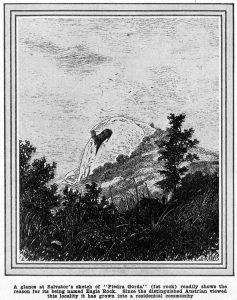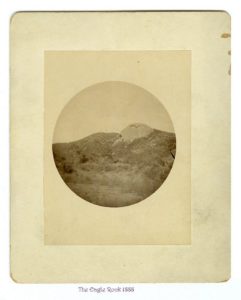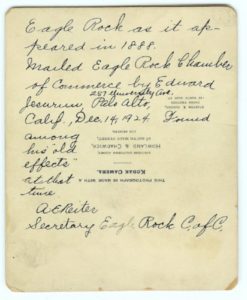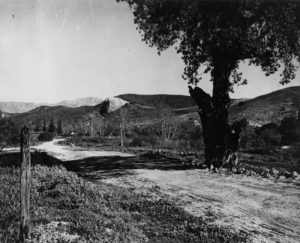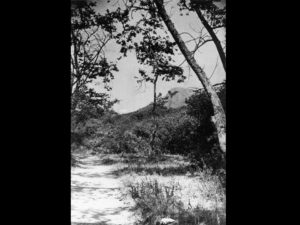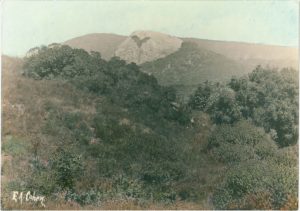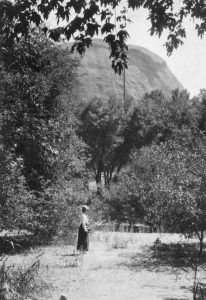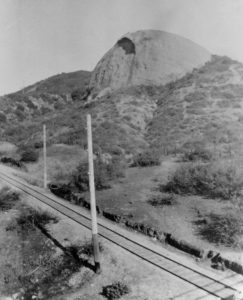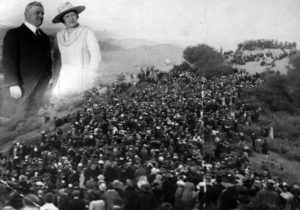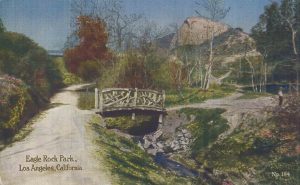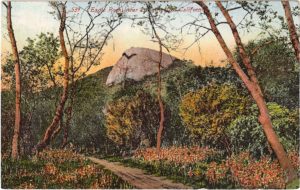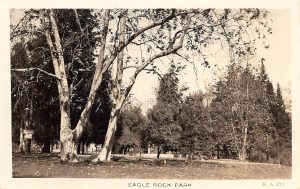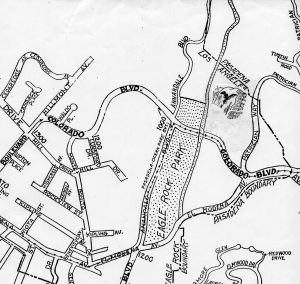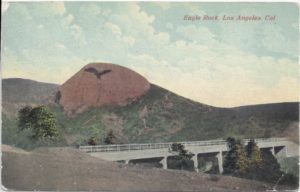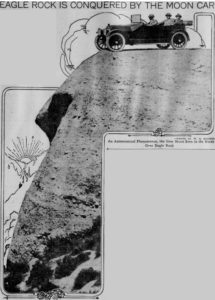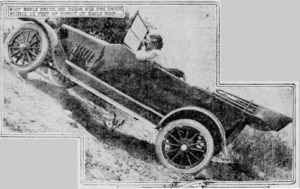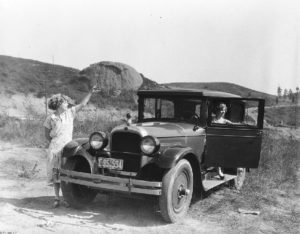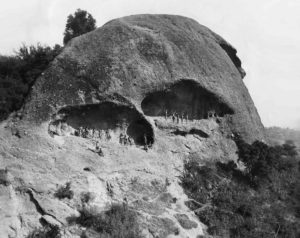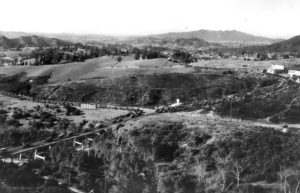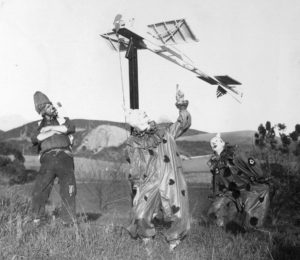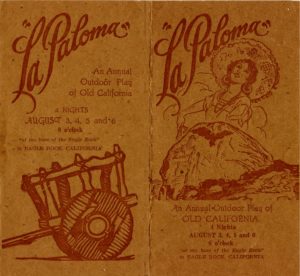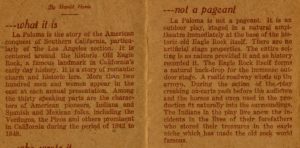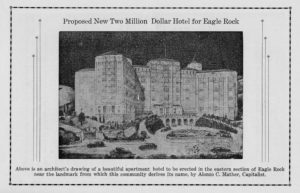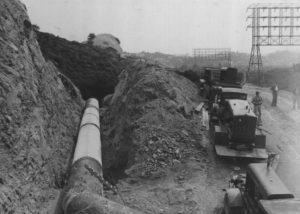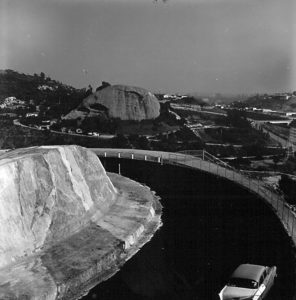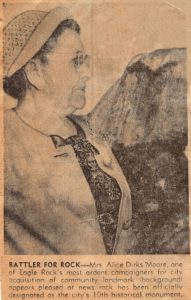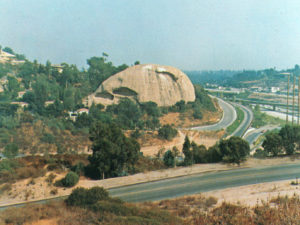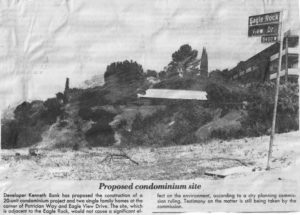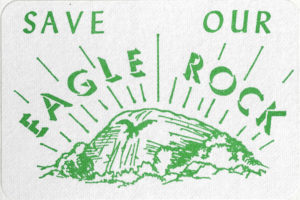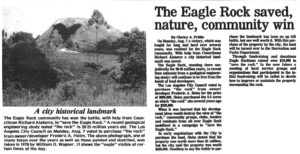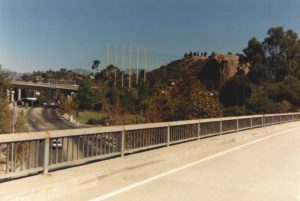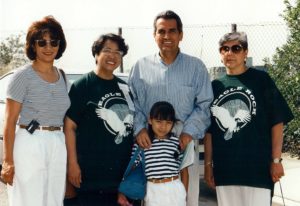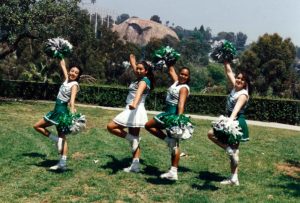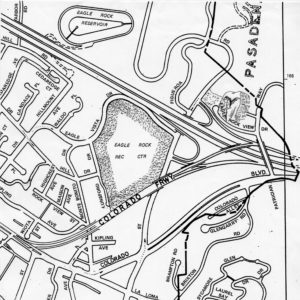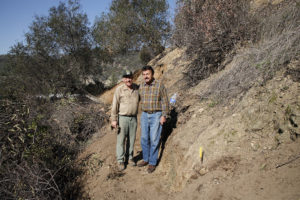The Eagle Rock
This rustic bridge crossed the stream in Huntington’s park below the Eagle Rock. Visible on the left above center is the bridge that led from Eagle Rock to Pasadena. This was the easiest crossing of the highly variable stream seen in the foreground. The stream still flows in the open through the MWD land, under the dump road and behind the commercial buildings on the east side of Figueroa St just below the 134 Freeway exit bridge. (ERVHS)
This postcard shows the bridge built to further the connection of the San Fernando Valley through Eagle rock to the San Gabriel Valley via State Highway 134. The route ran up what is now Eagle Vista Avenue and crosser the valley about where the freeway crosses now. The Arroyo Seco Bridge completed this connection in 1913. (ERVHS)
GIRL PERFORMS NOTABLE FEAT
The first woman to attempt to drive an automobile up the dangerously steep sides of Eagle Rock to the summit is Miss Merle Smith of Dallas. Texas. Miss Smith daringly guided a Saxon Six to within 15 feet of the top of the lofty landmark, and only failed to reach her goal because the terrific grade of slippery limestone offered absolutely no traction. Every attempt to make the wheels of the Saxon take hold from there up proved futile.
Those who ridicule the woman who drives her car may sit up and take notice, for Eagle Rock has foiled a lot of men. And when Miss Smith was handling the car on the side of a cliff which was nearly straight up and slanted sideways about 30 degrees in addition, no man who was watching was particularly anxious to trade places with her.
The approach to the rock, which can only be climbed in an automobile from the rear, was no simple drive. It was necessary to plow uphill through high brush which became very slippery when pushed down by the front wheels. Steering was almost an impossibility, but. after considerable maneuvering, Miss Smith got the car up to the rock. Then came the real test.
Where the rock began there was a sharp edge which threatened to break the car in two. Sand bags were brought into play, and piled on either side. Beyond the bags was an abrupt sloping turn to the right. To get over the sand bags one had to go with a jump. And if one went too far beyond the bags it meant a Saxon over the cliff to the road, two hundred and fifty feet below. No one urged the dare-devil girl to attempt to go on, but she did go on, and kept going until within 15 feet of the top of the cliff was reached.
Getting the car down again was another story. Just an hour was required to get the car back to the slope of the bill in one piece. Inch by inch and foot-by-foot the Saxon was blocked down, for to let the car get away a second would have meant an accident.
When level ground was reached at last, all, especially the owner of the car, breathed easier, of course. Merle Smith never worried, for she is nervy and skillful at the wheel—a regular driver. Most of all, she had confidence in the car.
On the route to Pasadena in their 1926 Nash, these women stop to enjoy the view. Colorado Boulevard winds behind them, past the intersection with Annandale Boulevard (now Figueroa), seen at the edge of the door, across the bridge and up the hill heading for the Annandale Country Club, Sternberger’s Restaurant, and the Colorado Street Bridge. (University of Southern California Library, California Historical Society Collection)
In 1938 a major addition to the infrastructure in the canyon was the Metropolitan Water District pipeline from the Colorado River delivering water to the Los Angeles area. The 55” pipeline shown proceeds down Figueroa Street, under the Community garden in the former trolley right of way and thence to Palos Verdes. Another branch flows under Scholl Canyon to Santa Monica. Los Angeles’ share of the water was tapped in the 1950’s via the Eagle Rock Reservoir and a pipeline under Colorado Boulevard to the Silver Lake Reservoir. (Metropolitan Water District)
In 1961 the road through the canyon was built to deliver trash to the new Scholl Canyon Dump in Glendale. The County forced the road on Eagle Rock because Glendale, although it wanted the dump, was unwilling to connect it via Glenoaks Canyon, within its borders. The Dump was supposed to close in seventeen years. (Joe Friezer-Occidental College Library Special Collections & College Archives-Friezer Collection)
A proposal by developer Kenneth Bank in 1987 to build condominiums on a site between the rock and the 134 off-ramp stimulated considerable local opposition. As the rock was privately owned, development could not be easily prevented. A movement to “Save the Rock” was re-energized. (probably Joe Friezer photograph-Eagle Rock Sentinel)
This photograph depicts the current road configuration in front of the rock. The 134 Freeway off-ramp is in the foreground. Figueroa Street runs to the dump road at left. In the middle distance is the 134 Freeway, which was constructed in 1970. The Edison Company power lines are carried on the monopoles, center. The rock and surrounding hills are at left. (ERVHS)
Angie Alatorre; Eagle Rock Field Deputy, Ruby de Vera; 14th District Councilmember Richard Alatorre, holding Melinda Ramos; and Highland Park Field Deputy Juanita Martinez, hosted the dedication ceremony at the base of the Rock in 1996. Finally the icon for which the community was named was publicly owned and would be preserved from inappropriate development. After the ceremony, a community fair, car show and concert were held at the recreation center. (John Miller Photograph-ERVHS)
John Stillion, right, heard by chance that the four acres north of the rock were for sale. The Collaborative Eagle Rock Beautiful, using funds raised by the community to “Save the Rock”, was able to make a down payment toward the purchase of the land. Master trail builder Peter Schaller, left, volunteered to supervise construction of a trail to the top of the plot. The nearly one mile loop trail was completed in 2008 and is now open to the public. (Photograph by Harry Chamberlain)

